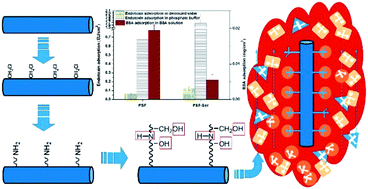A novel polysulfone-based affinity membrane with high hemocompatibility: preparation and endotoxin elimination performance
Abstract
A polysulfone (PSF)-based hollow fiber affinity membrane for in vitro endotoxin elimination was explored and prepared successfully. This depended on the well-known hemocompatibility of PSF membrane. The PSF hollow fiber membranes were firstly activated by a chloromethylation reaction, and treated with ethylenediamine and glutaraldehyde successively. L-Serine (Ser) was finally immobilized on the surface of the membranes as the functional ligand. The modified membrane was confirmed by X-ray photoelectron spectroscopy, attenuated total reflectance Fourier transform infrared spectroscopy, and contact angle analysis. L-Ser density up to 8.4 μmol cm−2 on PSF membranes could be achieved. The adsorption performance was preliminarily studied by comparing the PSF membrane and PSF–Ser membrane in deionized water and sodium phosphate buffer, showing that the PSF–Ser membrane had improved endotoxin adsorption capacity with decreased Bovine Serum Albumin (BSA) adsorption. The PSF–Ser membrane was further investigated in human plasma, and showed excellent removal efficiency and specificity for endotoxin. These results demonstrate the promising application potential of this novel affinity membrane in sepsis therapy.


 Please wait while we load your content...
Please wait while we load your content...